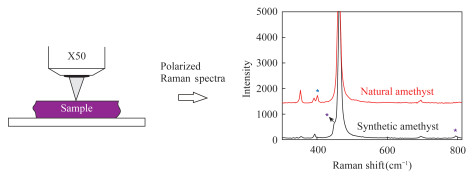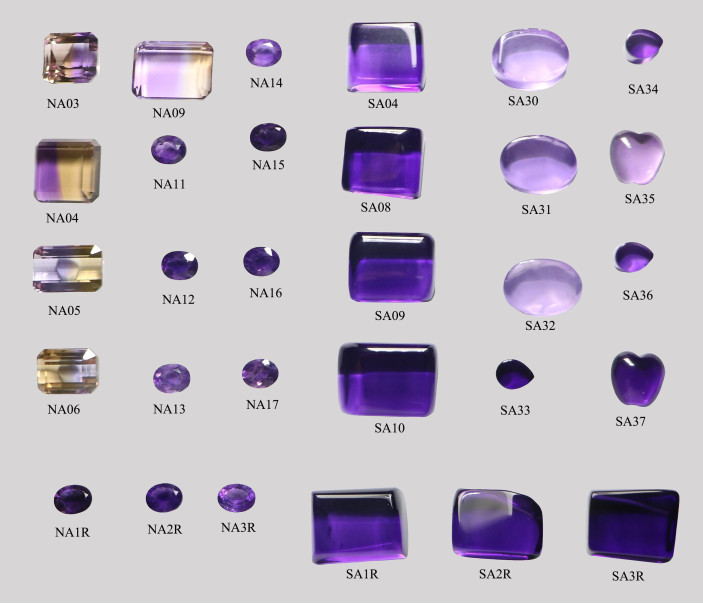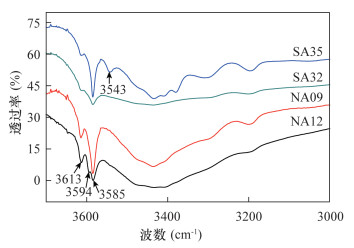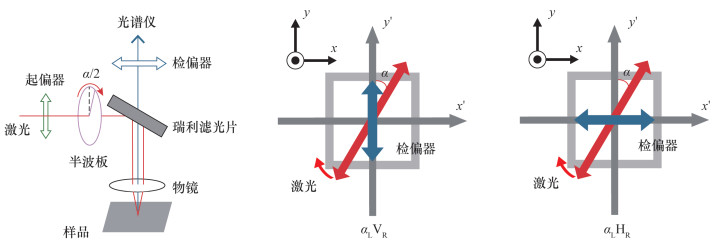Identification Characteristics of Natural and Synthetic Amethyst by Infrared and Polarized Raman Spectroscopy
-
摘要: 天然紫晶与合成紫晶的鉴别是国内外珠宝鉴定实验室的一个难题,前人主要从双晶、色带、包裹体、红外吸收光谱特征等方面开展了研究。在利用红外光谱鉴别天然紫晶与合成紫晶时,不同的学者尚对3595cm-1或3543cm-1吸收峰作为诊断性还是指示性的判据存在不同认识。本文系统采集了典型的天然紫晶与合成紫晶样品,研究了利用红外光谱测试技术鉴别天然紫晶与合成紫晶的局限性,并尝试将偏振拉曼光谱应用于紫晶成因鉴别。结果表明:利用3595cm-1、3543cm-1红外吸收峰进行紫晶鉴别仅具有指示性意义,不能作为决定性的判定依据,偏振拉曼光谱可作为重要的补充。天然紫晶的偏振拉曼光谱(偏振方向:HH)均出现400cm-1的拉曼峰,而该峰在合成紫晶偏振拉曼光谱中缺失;合成紫晶的偏振拉曼光谱(偏振方向:HH)均具有795cm-1、448cm-1的拉曼峰,而这两个峰在天然紫晶偏振拉曼光谱中缺失。偏振拉曼光谱产生差异的原因可能与天然紫晶和合成紫晶内部晶格变形程度的不同有关。本文揭示的400cm-1、448cm-1和795cm-1偏振拉曼峰可作为鉴别紫晶成因的新依据。要点
(1) 3595cm-1、3543cm-1红外吸收峰对鉴别天然紫晶与合成紫晶仅具有指示性意义。
(2) 对比了天然紫晶与合成紫晶的偏振拉曼光谱特征。
(3) 400cm-1、448cm-1和795cm-1偏振拉曼峰可作为鉴别紫晶成因的新依据。
HIGHLIGHTS(1) The infrared absorption peaks of 3595cm-1 and 3543cm-1 were found to be indicative only for the identification of natural and synthetic amethyst.
(2) The polarization Raman spectra of natural and synthetic amethyst were compared.
(3) The polarization Raman peaks of 400cm-1, 448cm-1 and 795cm-1 can be used as a new basis for source determination of amethyst.
Abstract:BACKGROUNDThe identification of natural and synthetic amethyst is still a challenge for gemological laboratories either at home or abroad. Previous studies focus on twinning, color band, inclusions and the infrared spectrum. Controversy still exists on whether the 3595cm-1 and 3543cm-1 absorptions are indicative or conclusive clues when employing infrared spectroscopy to separate natural amethyst from synthetics.OBJECTIVESTo characterize the features of natural and synthetic amethyst.METHODSTypical natural and synthetic amethyst samples were collected. The limitations of infrared spectroscopy to identify natural and synthetic amethyst were studied. The polarized Raman spectroscopy was applied to the identification of amethyst genesis.RESULTSThe results showed that there were some limitations in the origin determination of amethyst by using the infrared absorption peaks of 3595cm-1 and 3543cm-1 as criteria. These peaks were indicative, but cannot be used as a decisive basis. The polarized Raman spectrum was complementary to infrared spectroscopy. The polarized Raman spectrum (the direction of both incident laser and Raman signal set as horizon-HH) peak of 400cm-1 were observed in all the natural amethyst, but this peak was absent in the synthetics. The polarized Raman spectrum (direction:HH) peaks of 795cm-1 and 448cm-1 appeared in all the synthetic amethyst, but were not detected in natural amethyst.CONCLUSIONSThe difference of polarized Raman spectra may be related to different degree of crystal lattice deformation in natural and synthetic amethyst. The polarized Raman peaks of 400cm-1, 448cm-1 and 795cm-1 can be used as a new criterion for source determination of amethyst.
-
铜矿床的伴生元素Co、Ag、Au、Pd、Pt、Fe、Cd、Bi、In、Tl、Se、Te等都具有较高的经济价值,而目前这些伴生元素没有获得有效应用,其原因在于没有相应的研究方法对这些伴生元素进行深入研究,使其赋存特征不清楚,直接影响了原生铜矿床的评价、开采和选炼[1-6],进而影响了铜矿床的价值和开发技术路线的设定,导致资源流失较为严重。
传统的化学分析方法[7-8]可以测定铜矿床成矿元素含量,现代大型分析仪器如X射线荧光光谱法(XRF)[9]、电感耦合等离子体质谱法(ICP-MS)[10]可以解决伴生元素的微量分析问题,但上述方法均是通过样品的碎样加工、溶解或是粉末压片分析,其结果反映的是岩石矿物的整体状况,不能反映矿物的个体信息[11]。光学显微镜鉴定虽然能提供一定粒径的矿物学相关信息,但由于一方面受到光学显微镜放大倍数的制约,另一方面受到矿物本身的限制(如矿物被氧化、蚀变、包裹等情况),矿物的光性特征会随之发生一定的变化。铜矿床中的伴生矿物往往颗粒细小,从微米级到纳米级,元素或以类质同象[12]形式存在于其他矿石矿物中,以往由于技术条件的限制而难以被发现和利用。就铜矿床中常见的金矿物而言,自然金是原生金矿石最主要的金矿物,在扫描电镜(SEM)出现以前,只有粒径大于200μm的金矿物才能被光学显微镜发现,而现在的电子探针、扫描电子显微镜[13]已能观察、测定纳米级的矿物[14]。Wang等[15]利用透射电子显微镜(TEM)和扫描俄歇显微镜(SAM)分析观察到20~100nm的金颗粒。但是,由于种种原因,漏测、错定的现象常有发生,一是受仪器分辨率所限,例如探测极限很高的同步辐射X射线荧光光谱仪[16]、扫描质子探针[17]等也无法获得微细矿物的形貌特征;二是即使有足够的分辨率,在常规分析条件下也难以发现和鉴别这些微细矿物。到目前为止,中国还没有相关的一套标准方法可以借鉴。因此,鉴定这类较复杂的矿物时,特别是研究矿床中具有较高经济价值的Au、Ag、Co、Se、W、Ge、Cd等伴生元素时[18-21],由于其所含元素的成分未知、赋存状态及含量特征各异,其微区分析方法有别于矿床中常见主成矿元素的分析方法。
本文以“里伍式”铜矿床中的矿石矿物为研究对象,通过低倍的背散射图像捕获了矿物的异常灰度,找到其赋存的空间,结合高倍背散射图像完成赋存状态、矿物间相关关系等物相特征的观察;利用二次电子像获取矿物的晶体形态等形貌特征;利用能量色散X射线荧光光谱仪的点、线、面分析方法,获得铜矿床伴生元素矿物定性/定量及分布规律等信息,解决了铜矿床伴生矿物微细不易辨识、容易遗漏和错定的难题,形成了一套有关铜矿床伴生元素的能谱-扫描电镜(EDX-SEM)[22-24]微区分析方法,为矿产资源的综合利用提供重要支持。
1. 实验部分
1.1 样品采集及制备
铜矿床的种类繁多,矿物成分和微区形貌特征变化多样。本次方法研究选取“里伍式”铜矿床的矿石矿物[25]:黄铜矿、辉铜矿、孔雀石等为研究对象。样品选自四川九龙县里伍铜矿床,不同的编号代表不同的采样地点,相关信息见表 1。
表 1 矿石样品采集信息及化学分析结果Table 1. Collection information and chemical analysis results of ore samples样品编号 矿石性状或岩性 采样地点 Cu含量(×10-2) Au含量(×10-6) Ag含量(×10-6) KKLWB2-1 块状矿石 里伍本部B2矿体 12.92 0.30 < 10.0 KKLWB2-2 块状矿石 里伍本部B2矿体 21.70 0.31 < 10.0 KKLWB2-5 块状矿石 里伍本部B2矿体 3.70 < 0.10 16.8 KKLWB2-6 块状矿石 里伍本部B2矿体 1.56 < 0.10 < 10.0 JKLWB2-7 浸染状矿石 里伍本部B2矿体 4.15 0.17 16.8 WYLWB2-16 浸染状矿石 里伍本部B2矿体 - 0.15 < 10.0 WYLWB2-17 浸染状矿石 里伍本部B2矿体 - 0.15 < 10.0 KKLW-3 块状矿石 里伍本部 3.04 < 0.10 < 10.0 KKLWB1-1-1 块状矿石 里伍本部B1矿体 16.55 < 0.10 17.9 KKLWA2-3 块状矿石 里伍本部A2矿体 10.06 0.72 59.0 KKLWA2-8 块状矿石 里伍本部A2矿体 7.37 0.55 64.9 GKLWE1-8 网脉状-块状矿石 里伍本部E1矿体 5.45 0.14 123.0 GKLWA2-10 网脉状-块状矿石 里伍本部A2矿体 3.93 0.16 36.3 GKLWA2-11 网脉状-块状矿石 里伍本部A2矿体 10.98 2.38 16.5 KKHN-1 块状矿石 黑牛洞 19.99 0.11 < 10.0 KKHN-2 块状矿石 黑牛洞 14.74 0.18 < 10.0 KKHN-3 块状矿石 黑牛洞 15.61 < 0.10 < 10.0 KKHN-4 块状矿石 黑牛洞 15.88 0.15 < 10.0 KKHN-7 块状矿石 黑牛洞 15.35 0.87 51.1 KKHN-13 块状矿石 黑牛洞 19.10 0.12 - HWJG-6 块状矿石 挖金沟 10.77 0.13 34.4 WJG-7 块状矿石 挖金沟 1.58 0.23 11.6 JK207H141/6 浸染状矿石 黑牛洞 - 0.20 < 10.0 TK207H154/5 条带状矿石 黑牛洞 - 0.16 14.2 KK207H16-1 块状矿石 黑牛洞 - 0.11 < 10.0 KK207H222/6 块状矿石 黑牛洞 - 0.13 33.0 KK207H234/6 块状矿石 黑牛洞 - 0.20 20.5 TKZK20841H18 条带状矿石 黑牛洞 - 0.12 - KKZZ-5 块状矿石 中咀 4.37 < 0.10 29.0 KKZZ-6 块状矿石 中咀 4.97 < 0.10 29.6 KKZZ-7 块状矿石 中咀 17.72 < 0.10 15.4 WY1P-7 二云母石英片岩 中咀 - 0.10 10.8 样品制备:观察野外采回的岩石标本,选取有代表性的区域进行切取(光片),然后粗磨、细磨、抛光制样,使其样品表面达到最佳光洁度。将制好的岩石光片放入干燥器内干燥一周左右,以确保在切割、抛光样品时,样品内的微孔、缝隙中吸附的水分被充分干燥。干燥好的光片在高真空镀膜仪中蒸镀碳导电膜,厚度控制在25nm左右。本次实验采集的矿石样品化学分析结果见表 1。
1.2 仪器及工作条件
实验采用显微镜和能谱-扫描电镜(EDX-SEM)从不同尺度观察和分析样品的形貌和性状。样品测试分析前采用Hitachi HUS-5GB真空镀膜仪在样品表面镀碳。
能谱-扫描电镜(EDX-SEM)为牛津能谱仪IE250X-Max50与日本日立Hitachi S-4800型场发射扫描电镜,扫描电镜二次电子分辨率可达到1nm,放大倍数为20~8×105。该仪器具体的工作条件列于表 2。
表 2 能谱-扫描电镜工作条件Table 2. Working conditions of EDX-SEM instrument实验内容 加速电压(kV) 发射电流(μA) 工作距离(mm) 处理时间(s) 活时间(s) 死时间 扫描电镜的背散射电子(BSE)观察 20 10 15 - - - 二次电子(SE)影像观察 20 10 15 - - - EDX定性分析 20 10 - 6 100 20%~40% EDX定量分析 20 10 - 6 100 20%~40% EDX线分析 20 10 - 2 依据线扫描的长短和元素含量高低而定 20%~40% EDX面分析 20 10 - 2 依据面分析区域大小和元素含量高低而定 20%~40% 1.3 实验步骤
1.3.1 扫描电镜(SEM)分析
运用日立S-4800型扫描电子显微镜,在加速电压20kV、发射电流10μA、工作距离15mm的条件下,根据铜矿矿物与载体矿物及基岩不同的灰度识别矿物,捕获不同粒径或同一粒径矿物的形态特征及其与金属矿物、脉石矿物间的包裹关系、穿插关系,以及在岩石中的分布规律等矿物学特征。在完成矿物的相关关系观察之后,采集二次电子,再利用二次电子图像,获得铜矿床伴生矿物的晶体形态、表面光洁度等形貌特征。
1.3.2 能谱(EDX)定性分析
在完成上述矿物学特征观察的同时,运用X射线光谱仪可快速、准确地对含量达千分之一的元素进行定性/定量分析,同时可清晰地呈现分析视域中组成元素的相关关系及分布规律等信息。首先利用点分析方法,对粒径较大的矿物,在同一矿物或同一灰度的矿物测几个点位,根据重现性给出正确的分析结果。对粒径较小的矿物,或存在环带等特殊结构的矿物进行线扫描分析,排除载体矿物组成元素的干扰,重构矿物组成元素的谱图,再利用面扫描分析可获得矿物间的穿插、包裹关系及元素在整个视域的分布规律,同时可防止矿物遗漏。面扫描分析也可以与线扫描分析同时进行,开展综合分析。
铜矿床样品伴生元素赋存状态研究实验的具体流程如图 1所示。
2. 结果与讨论
2.1 扫描电镜-能谱测量条件的优化
2.1.1 扫描电镜加速电压和发射电流的选择
本方法研究的元素中涵盖了从元素周期表第二周期到第六周期的元素,还有原子序数较高的元素Au,兼顾定量分析所需加速电压应为分析特征X射线激发电压的2~3倍的原则,在同一发射电流、对比度、亮度及放大倍数的条件下,分别用10kV、15kV、20kV、25kV的加速电压轰击样品。加速电压在10kV、15kV时,电子束无法激发出较高能量元素的特征X射线(如Fe、Ni元素的特征X射线未激发出),无法准确对矿物进行定性/定量分析;在20kV的加速电压下空间分辨率适中,激发出的背散射电子、特征X射线等电子信号强烈,背散射电子图像的灰度略低,对于原子序数较高的矿物会遗失部分矿物的细节特征,电子束能够激发Au元素等重元素的特征X射线,确保元素特征X射线信息的全面采集;25kV的加速电压较高,空间分辨率降低,激发的电子信号太强烈,得到的背散射电子图像灰度低,整个背散射电子图像呈亮色调,原子序数接近的矿物间不存在色差,无法观察到重原子组成矿物的细节特征。因此,考虑到整个方法的适用性及分析效率,本方法首选20kV作为加速电压的分析条件。
发射电流的大小与岩石中元素的含量相关。为确保铜矿床伴生元素在较低含量的情况下能检出元素的含量,尽可能地准确获取矿物中类质同象元素的相关信息,本实验选择束电流10μA为电流的分析条件。
2.1.2 能谱处理时间条件的选择
能谱处理处理时间长, 可以获得较好的谱图分辨率,避免重叠峰,获得准确的分析结果,但采集速率较低,耗时长。条件实验中分别为处理时间为6(档)和5(档)的条件下,对同一银金矿颗粒进行研究。结果表明处理时间为6(档)时,银金矿的元素含量为:Cu 0.81%,Fe 1.57%,Au 82.63%,Ag 14.99%;处理时间为5(档)时,得到的谱图中出现了元素U的干扰谱线(图 2),删除干扰谱线后银金矿中元素含量为:Cu 1.40%,Fe 0.80%,Au 79.38%,Ag 18.42%。从成分结果可以看出,主元素Au含量(Au 82.63%)高于处理时间为5(档)的条件下Au含量(Au 79.38%),可以理解为处理时间长,搜集到的主要元素的信号越多。考虑到结果精准性,基本上选择的处理时间都为最长时间6(档)。因此,选定活时间为100s,处理时间为6(档),对应的最佳死时间参数在20%~40%范围内。
2.2 铜矿床伴生元素矿物物相特征
矿物的背散射电子(BSE)的产率主要受元素的原子序数决定,矿物的组分及含量不同,所产生的背散射信号量也不同,因此成像区域中选择适中的灰度、形成色阶清晰的图像,是研究矿物赋存状态等物相特征的首要前提。在观察过程中,应遵循低倍下寻找矿物、高倍下观察矿物的原则,同时结合铜矿床伴生矿物的粒径特征,选择合适的观察倍数,获得适宜的观察视域,确保观察的系统性与全面性。其次是BSE观察到疑似目标矿物时,需经二次电子影像(SE)确认是否为光片内的自身矿物,而非污染物,同时应根据矿物的特征,选择有效放大倍率对代表性的区域进行观察,采用过高的放大倍数会减少矿物的形貌信息、降低观察效率。此外,还应规避二次电子边缘效应及调节适宜的对比度与亮度,使图像灰度适中,矿物细节清晰。
本次利用场发射扫描电镜观察, 发现铜矿床中伴生元素的存在形式为:①金元素[26-28]。主要以独立金矿物(图 3a)——银金矿形式(图 3中的b和c))分布在黄铜矿、磁黄铁矿的裂隙中,其次少量以类质同象(图 3d)形式分布在铋矿物和银矿物中。②银元素[29]。主要以独立银矿物单质银、块硫铋铅银矿、碲银矿(图 3e)、块辉铋铅银矿、硫铋银矿(图 3f)、硫铋金银矿、碲铋银矿、碲银矿的形式存在,这些银矿物主要以包裹体形式包裹在黄铜矿、闪锌矿、磁黄铁矿中,另外也有少量的Ag元素以类质同象形式分布在铋矿物(如单质铋、自然铋、叶碲铋矿)中,或以类质同象形式分布在方铅矿中。③钴元素[30-32]。主要以独立钴矿物硫锑钴矿形式存在,硫锑钴矿与磁黄铁矿共生,另外少量的钴元素以类质同象形式分布在独居石中。④铋元素。独立矿物有铋华、叶碲铋矿、赫碲铋矿、铋碲矿,这些铋矿物往往与碲矿物(如碲银矿)紧密共生(图 3中g、k、j),且往往呈包裹体形式主要分布在矿石矿物方铅矿(图 3i)、闪锌矿、黄铜矿、磁黄铁矿(图 3h)、铈独居石(图 3l)中。⑤硒元素[33]。主要以类质同象形式分布在方铅矿中。
2.3 铜矿床伴生元素特征
应用能谱进行铜矿床伴生元素成分点分析时,关键是要确认低含量的元素是否真实存在,这关系到检测极限的问题。在EDX定量分析的软件中,设有测试结果对应的标准偏差值,以3倍标准偏差值作为判定元素是否存在的依据。只需依据“质量百分含量>3δ或<3δ”进行取舍。如在测试银金矿的元素Fe、Cu、Ag、Au时,各元素的标准偏差分别为Fe 0.15,Cu 0.22,Ag 0.44,Au 0.49,以3倍标准偏差值作为判定元素是否存在依据,这些元素的质量百分含量分别为Fe 0.80%,Cu 1.40%,Ag 18.42%,Au 79.38%,符合要求。
开展线分析时,通常选择矿物背散射电子像明暗分布变化(即矿物成分变化)较明显的部位进行线定位,且铜矿床伴生矿物与载体矿物间的物相分界线应在分析视域的中心部位,以确保图像质量。本次实验在观察含Au矿物中Au元素的分布情况时,由于Au的含量较其他元素低,在图 4中的a和b(蓝色线为金的含量分布曲线)很难看出Au的含量情况及其与其他元素的相关关系,因此采取峰值曲线累加的办法,将Au元素在该直线上的含量分布情况放大累加显示出来(图 4c)。从图中可以看出,Au的含量在该直线较背景值含量高,并重复出现4个波峰峰值,由此说明,Au元素在该直线上的分布有变化,分别以类质同象形式分布在含铋的单矿物和含银的单矿物中,该载金矿物又嵌布于磁黄铁矿中,从而推断该单质铋是由辉铋矿或铋的硫化物氧化而来,Au、Ag元素可能为成矿后期在低温条件下随迁移富集并不均匀地分布在单质铋中。
本次利用能量色散X射线荧光光谱仪,测试条件设置为采集速率1.3kcps、采集时间100s、脉冲处理时间100μs,可准确地分析铜矿床伴生元素的组成及含量,结果列于表 3。从表中数据可以看出,铜矿床中的伴生元素Au、Ag、Co、Bi、Te、W等的含量被准确测出,并根据元素在矿物中含量,确定元素赋存状态。如:Au元素含量为98.74%,忽略背景值Fe 1.24%的含量,确定Au以自然金的形式存在。Au元素含量为86.23%,Ag含量为2.83%,忽略10.64%的背景值影响,确定Au以银金矿的形式存在。Co元素含量为24.23%,Sb含量为57.56%, S含量为15.59%,忽略Fe和Te分别为0.83%和1.89%的含量,确定Co元素赋存在硫锑钴矿中。用同样的方法,确定Bi以单质铋、赫碲铋矿、硫铋银矿、碲铋矿等形式存在;Te以碲铋矿、赫碲铋矿形式存在;W以白钨矿形式存在。
表 3 矿物能谱分析结果Table 3. Energy spectrum analysis results of the minerals矿物名称 化学式 元素含量(%) S Fe Co Sb Te Zn Te Bi Au Ag W Ca O 硫锑钴矿 CoSbS 15.59 0.83 24.13 57.56 1.89- - - - - - - - - 赫碲铋矿 Bi7Te3 - 0.73 - - - 3.12 24.70 71.45 - - - - - 赫碲铋矿 Bi7Te3 - 1.04 - - - 2.26 25.19 71.50 - - - - - 自然金 Au - 1.26 - - - - - - 98.74 - - - - 银金矿 AgAu - 1.06 - - - - - - 76.51 22.43 - - - 类质同象金 Au 3.15 4.11 - - 34.93 - - - 5.60 52.22 - - - 银金矿 AgAu - 10.64 - - - - - - 86.53 2.83 - - - 碲银矿 Ag2Te 1.61 3.42 - - - 37.38 - 57.59 - - - 硫铋银矿 AgBiS2 17.31 1.54 - - - - 0.98 65.53 - 14.65 - - - 单质铋 Bi - 3.73 - - - - 96.27 - - - - - 单质铋 Bi - - - - - - 100 - - - - - 碲铋矿 Bi2Te3 - - - - - - 36.62 63.38 - - - - - 碲铋矿 Bi2Te3 - - - - - - 46.75 53.25 - - - - - 白钨矿 CaWO4 - - - - - - - - - - 63.14 13.97 22.89 白钨矿 CaWO4 - 0.98 - - - - - - - - 60.55 13.59 24.88 注:“-”表示未能检出该元素。 在对粒径较小的矿物进行定量分析时,由于电子束呈水滴状扩散,载体矿物的组成元素同时会被激发,导致定量分析结果存在较大的不准确性。为了对定量分析结果进行修正,需结合元素的线、面分布图像排除载体矿物组成元素的干扰,重构待测矿物组成元素的谱图,以修订定量分析结果,进而获得元素在整个视域的分布规律、矿物间的穿插、包裹关系及分布规律等矿物学信息。
2.4 方法中的关键技术
综上所述,为了准确获得铜矿床伴生元素定性/定量及分布规律等信息,避免出现矿物的漏定和错定,本研究的重点在于如何确定含研究元素的独立矿物,而此时的矿物是光学显微镜及其他方法不能确定的,特点一定是粒径很小。因此,在研究前首先要判断元素可能以何种矿物形式存在(不常见的矿物需查阅矿物手册)[34],并且要根据可能的矿物计算其矿物平均原子序数,再根据平均原子序数估计BSE像的灰度范围,然后以合适的放大倍数观察样品,匹配适中的亮度、对比度,使得图像灰度适中、层次清晰,从而捕获所需矿物信息。
本次所研究的铜矿床伴生元素其原子序数均较高,因此,在低倍下观察时,将目标确定在矿物的背散射像较亮的矿物,然后放大观察,通过能谱点、线、面分析,排除基体干扰,确定其所含元素,进而得知特定元素在该矿物中的含量,从而了解该伴生元素的赋存特征。其次,制样过程中一定要保证分析面抛光,彻底清除表面污染物,样品至少保证在24h以上充分干燥,镀膜时考虑样品的特性确保所镀碳膜的厚度,粘接样品时一定要保证粘稳。
3. 结论
本文建立了铜矿床伴生元素的赋存状态特征的EDX-SEM分析方法,该方法解决了铜矿床伴生矿物微细不易辨识、容易遗漏和错定的难题,通过低、高倍的背散射图像、二次电子像以及能谱色散X射线荧光光谱仪点、线、面分析等技术手段的相互结合,消除基体干扰,确保了测试数据的准确性。优化选取扫描电镜的加速电压20kV、发射电流10μA、能谱脉冲处理活时间100s,准确获得矿物定性/定量及分布规律等信息。通过该方法,查明了里伍铜矿床矿石中金、银、钴、铋、硒等伴生元素的赋存状态,这些元素以独立矿物存在或类质同象的形式分布在黄铜矿、闪锌矿、磁黄铁、铈独居石等其他矿物中。
本研究结果为矿床的成因研究、资源评价、勘查手段以及矿山的开采、选矿以及冶炼工艺过程的制定等地质工作提供了充分的微观依据。
致谢: 感谢广东省珠宝玉石及贵金属检测中心宁海波先生在样品收集过程中提供的帮助。 -
表 1 天然紫晶与合成紫晶的样品信息
Table 1 Sample distribution of natural and synthetic amethyst
样品类别 样品编号 样品数量 颜色 天然紫晶 NA03~NA06,NA09 5 浅紫色/黄色 NA11~NA17,NA1R~NA3R 10 深紫色 合成紫晶 SA1R~SA3R,SA04,SA08~SA10,
SA33,SA34,SA36,SA3711 深紫色 SA30~SA32,SA35 4 浅紫色 -
Lehmann G, Moore W J.Color center in amethyst quartz[J].Science, 1966, 152(3725):1061-1062. doi: 10.1126/science.152.3725.1061
Balitsky V S.Growth of large amethyst crystals from hydrothermal fluoride solutions[J].Journal of Crystal Growth, 1977, 41(1):100-102. doi: 10.1016/0022-0248(77)90102-6
Khadzhi V E, Tsyganov E M, Tsinober L I, et al.Process for producing amethyst crystals: US, US4021294[P].1977.
Crowningshield R, Hurlbut C, Fryer C W.A simple pro-cedure to separate natural from synthetic amethyst on the basis of twinning[J].Gems & Gemology, 1986, 22(3):130-139.
Balitsky V S, Lu T, Rossman G R, et al.Russian synthetic ametrine[J].Gems & Gemology, 1999, 35(2):122-134. http://d.old.wanfangdata.com.cn/NSTLQK/NSTL_QKJJ023992489/
Balitsky V S, Balitsky D V, Bondarenko G V, et al.The 3543cm-1 infrared absorption band in natural and synthetic amethyst and its value in identification[J].Gems & Gemology, 2004, 40(2):146-161. http://www.wanfangdata.com.cn/details/detail.do?_type=perio&id=fcfa036581188d37fa18214578374d43
Fritsch E, Stockton C M.Infrared spectroscopy in gem iden-tification[J].Gems & Gemology, 1987, 23(1):18-26.
Karampelas S, Fritsch E, Zorba T, et al.Distinguishing natural from synthetic amethyst:The presence and shape of the 3595cm-1 peak[J].Mineralogy & Petrology, 2005, 85(1-2):45-52.
Breeding C M.Using LA-ICP-MS analysis for the separation of natural and synthetic amethyst and citrine[EB/OL].News from Research, July 31, 2009. http://www.gia.edu/research-resources/news-from-research.
Koivula J I, Fritsch E.The growth of Brazil-twinned synthetic quartz and the potential for synthetic amethyst twinned on the Brazil law[J].Gems & Gemology, 1989, 25(3):159-164.
Karampelas S, Fritsch E, Zorba T, et al.Infrared spectro-scopy of natural vs.synthetic amethyst:An update[J].Gems & Gemology, 2011, 47(3):196-201.
Kitawaki H.Natural amethyst from the Caxarai Mine, Brazil, with a spectrum containing an absorption peak at 3543cm-1[J].Journal of Gemmology, 2002, 28:101-108. doi: 10.15506/JoG.2002.28.2.101
Karampelas S, Fritsch E, Zorba T, et al.A refined in-frared-based criterion for successfully separating natural from synthetic amethyst[J].Gems & Gemology, 2006, 42(3):155.
Kiefert L, Karampelas S.Use of the Raman spectrometer in gemmological laboratories:Review[J].Spectrochimica Acta Part A:Molecular & Biomolecular Spectroscopy, 2011, 80(1):119-124. http://med.wanfangdata.com.cn/Paper/Detail/PeriodicalPaper_PM21530372
Häanni H A, Kiefert L, Chalain J P, et al.A Raman mi-croscope in the gemmological laboratory:First experiences of application[J].Journal of Gemmology, 1997, 25(6):394-406. doi: 10.15506/JoG.1997.25.6.394
陈学军, 王以群, 毛荐.天然与合成紫晶的光谱学特征及其呈色机理[J].华东理工大学学报, 2011, 37(3):320-324. doi: 10.3969/j.issn.1006-3080.2011.03.012 Chen X J, Wang Y Q, Mao J.Spectral characteristics and coloration mechanism of natural and synthetic amethyst[J].Journal of East China University of Science and Technology, 2011, 37(3):320-324. doi: 10.3969/j.issn.1006-3080.2011.03.012
曹盼, 虞澜, 祖恩东.天然水晶和水热法合成水晶的拉曼光谱分析[J].光散射学报, 2017, 29(1):50-53. http://d.old.wanfangdata.com.cn/Periodical/gssxb201701009 Cao P, Yu L, Zu E D.Study on Raman spectrum of natural crystal and synthetic crystal by hydrothemal method[J].The Journal of Light Scattering, 2017, 29(1):50-53. http://d.old.wanfangdata.com.cn/Periodical/gssxb201701009
周丹怡, 陈华, 陆太进, 等.基于拉曼光谱-红外光谱-X射线衍射技术研究斜硅石的相对含量与石英质玉石结晶度的关系[J].岩矿测试, 2015, 34(6):652-658. doi: 10.15898/j.cnki.11-2131/td.2015.06.008 Zhou D Y, Chen H, Lu T J, et al.Study on the relationship between the relative content of moganite and the crystallinity of quarzite jade by Raman scattering spectroscopy, infared absorption spectroscopy and X-ray diffraction techniques[J].Rock and Mineral Analysis, 2015, 34(6):652-658. doi: 10.15898/j.cnki.11-2131/td.2015.06.008
刘亚非, 王立社, 魏小燕, 等.应用电子微探针-扫描电镜-拉曼光谱-电子背散射衍射研究一种未知Ti-Zr-U氧化物的矿物学特征[J].岩矿测试, 2016, 35(1):48-55. doi: 10.15898/j.cnki.11-2131/td.2016.01.009 Liu Y F, Wang L S, Wei X Y, et al.Study on the mineralogical properties of an unknown Ti-Zr-U oxide using EPMA, SEM, Raman spectroscopy and EBSD techniques[J].Rock and Mineral Analysis, 2016, 35(1):48-55. doi: 10.15898/j.cnki.11-2131/td.2016.01.009
胡哲, 郭颖.粉色水晶内针状包裹体的成分与分布特征研究[J].岩矿测试, 2018, 37(3):306-312. doi: 10.15898/j.cnki.11-2131/td.201709150152 Hu Z, Guo Y.Study on the component and distribution characteristics of needle like inclusions in rose quarz[J].Rock and Mineral Analysis, 2018, 37(3):306-312. doi: 10.15898/j.cnki.11-2131/td.201709150152
Liu X L, Zhang X, Lin M L, et al.Different angle-resolved polarization configurations of Raman spectroscopy:A case on the basal and edge plane of two-dimensional materials[J].Chinese Physics B, 2017, 26(6):067802. doi: 10.1088/1674-1056/26/6/067802
Bates J B, Quist A S.Polarized Raman spectra of β-quartz[J].The Journal of Chemical Physics, 1972, 56(4):1528-1533. doi: 10.1063/1.1677402
Zhang X, Han W P, Wu J B, et al.Raman spectroscopy of shear and layer breathing modes in multilayer MoS2[J].Physical Review B, 2013, 87(11):115413. doi: 10.1103/PhysRevB.87.115413
Islam M M, Datchi F.Polarized Raman Spectra of α-quartz[J].International Letters of Chemistry, Physics and Astronomy, 2015, 56:91-98. doi: 10.18052/www.scipress.com/ILCPA.56.91
Aines R D, Rossman G R.Water in minerals? A peak in the infrared[J].Journal of Geophysical Research:Solid Earth, 1984, 89(B6):4059-4071. doi: 10.1029/JB089iB06p04059
Bell D R, Rossman G R.Water in Earth's mantle:The role of nominally anhydrous minerals[J].Science, 1992, 255(5050):1391-1397. doi: 10.1126/science.255.5050.1391
Rossman G R.Studies of OH in nominally anhydrous mi-nerals[J].Physics and Chemistry of Minerals, 1996, 23(4-5):299-304.
Thomas S M, Koch-Müller M, Reichart P, et al.IR calibrations for water determination in olivine, γ-GeO2, and SiO2 polymorphs[J].Physics and Chemistry of Minerals, 2009, 36(9):489-509. doi: 10.1007/s00269-009-0295-1
Müller A, Kochmüller M.Hydrogen speciation and trace element contents of igneous, hydrothermal and metamorphic quartz from Norway[J].Mineralogical Magazine, 2009, 73(4):569-583. doi: 10.1180/minmag.2009.073.4.569
Scott J F, Porto S P S.Longitudinal and transverse op-tical lattice vibrations in quartz[J].Physical Review, 1967, 161(3):903-910. doi: 10.1103/PhysRev.161.903
Bailey S W, Bell R A, Peng C J.Plastic deformation of quartz in nature[J].Geological Society of America Bulletin, 1958, 69(11):1443-1466. doi: 10.1130/0016-7606(1958)69[1443:PDOQIN]2.0.CO;2
Blacic J D, Christie J M.Plasticity and hydrolytic wea-kening of quartz single crystals[J].Journal of Geophysical Research:Solid Earth, 1984, 89(B6):4223-4239. doi: 10.1029/JB089iB06p04223
Morrison-Smith D J, Paterson M S, Hobbs B E.An electron microscope study of plastic deformation in single crystals of synthetic quartz[J].Tectonophysics, 1976, 33(1-2):43-79. doi: 10.1016/0040-1951(76)90051-2
-
期刊类型引用(5)
1. 符招弟,张晓娟,杨林. 伟晶岩型锂矿石中锂的化学物相分析方法研究. 岩矿测试. 2024(03): 432-439 .  本站查看
本站查看
2. 彭晶晶,林锴. 锂矿成矿规律研究的知识图谱分析. 中国矿业. 2024(09): 228-235 .  百度学术
百度学术
3. 王成辉,王登红,刘善宝,张永生,王春连,王九一,周雄,代鸿章,于扬,孙艳,邢恩袁. 战略新兴矿产调查工程进展与主要成果. 中国地质调查. 2022(05): 1-14 .  百度学术
百度学术
4. 郭晓剑,胡欢,刘亦晴,梁雁茹. 基于CiteSpace的我国绿色矿山研究可视化分析. 黄金科学技术. 2020(02): 203-212 .  百度学术
百度学术
5. 叶亚康,周家云,周雄. 川西塔公松林口岩体LA-ICP-MS锆石U -Pb年龄与地球化学特征. 岩矿测试. 2020(06): 921-933 .  本站查看
本站查看
其他类型引用(4)



 下载:
下载:








 京公网安备 11010202008159号
京公网安备 11010202008159号